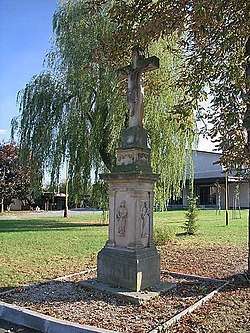Králíky (Hradec Králové District)
Králíky is a village in eastern Bohemia of the Czech Republic. It is a part of Hradec Králové Region. The nearest town is Nový Bydžov. This village is often mismatched with the town of Králíky in northern Moravia. There are three villages nearby that belong to Králíky. Řehoty, Podoliby and Chmelovice. A few years ago, the names of the nearby villages were Králíky Řehoty, Králíky Podoliby and Králíky Chmelovice.
Králíky | |
|---|---|
Village | |
 | |
 Králíky Location in the Czech Republic | |
| Coordinates: 50°15′53″N 15°32′10″E | |
| Country | Czech Republic |
| Region | Hradec Králové |
| District | Hradec Králové |
| Little District | Nový Bydžov |
| First mentioned | 1635 |
| Government | |
| • Mayor | Tomáš Pohl |
| Area | |
| • Total | 9.68 km2 (3.74 sq mi) |
| Elevation | 235 m (771 ft) |
| Population (2008-07-29) | |
| • Total | 404 |
| • Density | 42/km2 (110/sq mi) |
| Time zone | UTC+1 (CET) |
| • Summer (DST) | UTC+2 (CEST) |
| Postal code | 503 15 - 504 01 |
Population
According to Vokálová (2008),[1] Králíky has 404 inhabitants, including the administrative parts. 232 of them live in Králíky itself, 55 in Řehoty, 81 in Podoliby and 36 in Chmelovice. Currently, the population is still increasing. Considering the whole area, population density is 41.7 people per square kilometer.
Vokálová (2001)[1] states that 53.3% of the population are women. Furthermore, 18.2% of all people is between 0–14 years, 67.2% is working population and 14.6% are in retiring age. Average age is about 34.4 years. 31.2% of all local people reached only elementary education, 47.2% are qualified with secondary education, 17% have complete secondary education with a school leaving exam and 2.8% have no education.
History
Králíky (Kralice in those times) was established in the 16th century. In those times, the village was devastated and the first record dates back to 1635. In 1654, there were only 13 cottages (in comparison with the present time (2013), there are approximately 60 houses and 5 blocks of flats). It was restored in 1686 when the German people came there. The Germans translated the name of the village incorrectly and called Králíky "New Yard". In 1720, they changed the name to "Králík" ("Rabbit").
History of Řehoty is more mysterious. There was no written evidence about it until 1549. However, the establishment dates back to the 11th or 12th century. A first record of this village is from March 25, 1549. That day the town of Nový Bydžov bought this hamlet, Prasek and Zdechovice from John III of Pernstein (Jan z Pernštejna). In 1623, Řehoty village was desolate and was an administrative part of Prasek. In the 18th century, three families came and Řehoty started to expand. The greatest expansion was in the 19th century. Řehoty village was annexed to Králíky in 1960. There are 25 houses at present time. A famous Czech psychologist Jan Nepomuk Kapras (1847-1931) comes from Řehoty.
Podoliby is also a very old village, documented in 1363 for the first time. There were only two homesteads and nine cottages until 1654. It belonged to Havel Zvířetický of Wartenberg who sold the town of Nový Bydžov, including the attached villages, to William II of Pernstein (Vilém z Pernštejna). After him, Kryštof Erazim Sommerfeld was the person in possession of Podoliby. The village was sold again in 1623 to Albrecht von Wallenstein (Albrecht z Valdštejna). The Thirty Years' War caused destroying it, nevertheless, it did not cease to exist. It expanded again in the 18th century and a school was built there in 1882.
Chmelovice was founded in 1786. Four years later, there were already 11 houses. In 1835 there lived 93 inhabitants. However, there are only 36 people nowadays. (cf. Vokálová, 2008)[1]
Public facilities
There is no post office, no health centre, no police station and no schools in Králíky. There is a community centre which is rented every year for many cultural events and Music Club Max. Children from Králíky and Řehoty commute to schools to Nový Bydžov, children from Podoliby and Chmelovice to Petrovice and Skřivany. Health care is also provided in Nový Bydžov.[2]
References
- Vokálová, M. (2001). Králíky a přilehlé obce podrobně ("Králíky and contiguous villages in detail"). July 29, 2008. Retrieved April 7, 2013.
- Janeček, T. Personal experience. April 8, 2013.